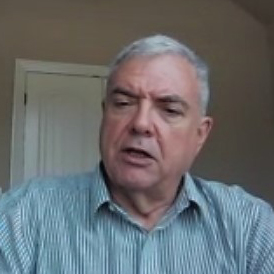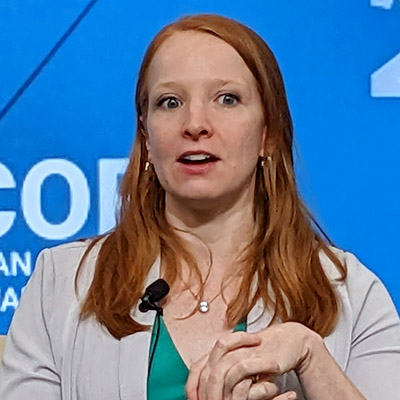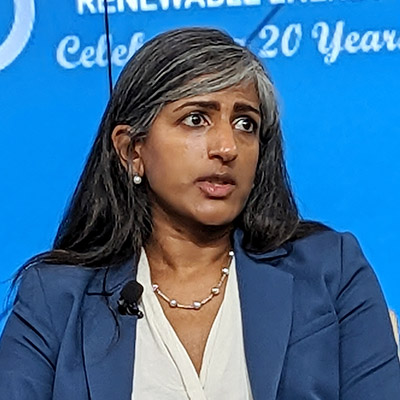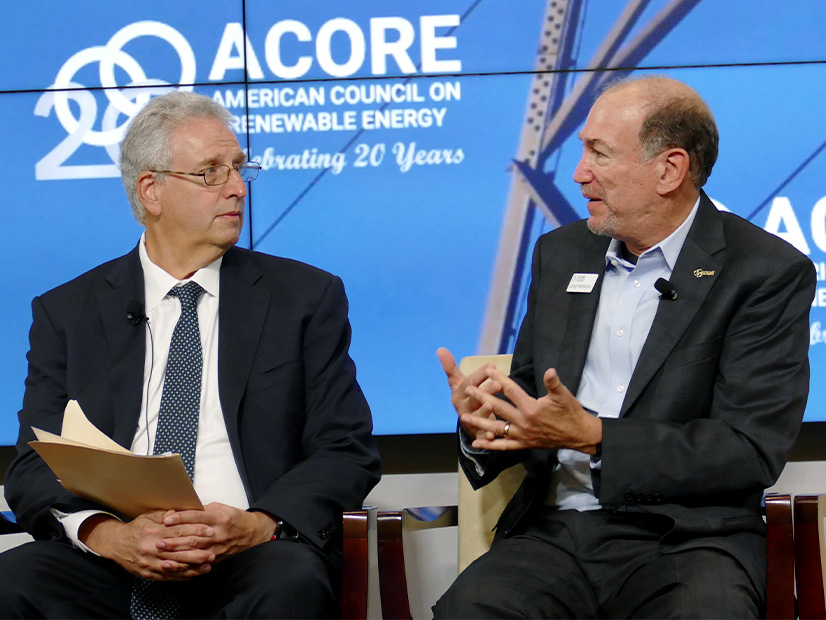RTOs, utilities and others told FERC Friday it should drop its proposal to penalize transmission providers for failing to meet interconnection study deadlines, while generation developers balked at the commission’s proposed “commercial readiness” provisions.
More than 130 companies, agencies and organizations filed comments in response to FERC’s June 16 Notice of Proposed Rulemaking (NOPR) to clear clogged interconnection queues and give generators more certainty on upgrade costs (RM22-14). (See FERC Proposes Interconnection Process Overhaul.)
Commenters generally supported the NOPR’s proposal to replace the serial “first-come, first-served” study procedure with “first-ready, first-served” cluster studies.
The American Clean Power Association said the NOPR “contains many potentially valuable improvements to current interconnection policies,” calling for new rules to “provide predictability on the timetable for interconnection studies, as well as certainty on the upgrade costs that are identified through these studies.”
The Environmental Defense Fund said the changes were needed to address the “inequitable distribution of costs among interconnection customers based on the first-come, first served study process [and] delays created by the proposal and withdrawal of speculative projects [and] the lack of binding deadlines for transmission providers [and] the general failure of transmission providers to evaluate use of alternative transmission technologies.”
Calls for More Outreach
But there were disagreements on many of the details, and several commenters called for additional outreach before issuance of a final rule.
The Electric Power Supply Association said FERC may need to collect additional comment or convene a technical conference to work out the details. “Competitive generators strongly support a timely final rule from the commission to address long-plagued interconnection queues, but getting that rule as clear as possible saves time in the end for all stakeholders, including customers.”
CAISO said that “although many of the individual proposals in the NOPR are ripe for implementation, the sum of the NOPR would not achieve the commission’s goals and would instead slow study processes and increase backlogs.
“The CAISO strongly urges the commission to iterate with stakeholders further before issuing a final rule. At the very least the commission should issue a revised NOPR based on comments and should consider technical conferences on ISO/RTO-specific reforms, commercial readiness criteria and realistic study timelines.”
Regional Flexibility
The many state agencies that issued comments on the NOPR were broadly supportive of the changes to interconnection rules, which they said could help alleviate backlogs that are hurting their states. But they urged FERC not to interfere with existing regional efforts to make their processes more efficient.
“The imposition of overly prescriptive compliance obligations may disrupt and potentially dismantle many of the successful processes and practices already underway in the MISO region,” the Organization of MISO States wrote. “As such, we recommend that the commission permit transmission providers that are initiating their own stakeholder-supported interconnection reforms … to continue developing regionally appropriate solutions.”
“The commission should be sensitive and avoid creating additional burdens to those regions that have already adopted best practices,” MISO said. “Any proposed reform should be careful not to burden transmission providers by imposing non-essential or regionally inappropriate requirements to already-strained interconnection queue study processes and inadvertently increase the duration of the interconnection queue or risk of delays.”
“In discussing the need for queue reforms, the NOPR does not appear to recognize the different approach that New England has taken to interconnection-related network upgrade costs,” the New England States Committee on Electricity wrote. ISO-NE also asked the commission to avoid a “prescriptive” final rule.
The Edison Electric Institute also called for flexibility. “For example, FERC should allow transmission providers to develop the technical details for cluster studies, including how clusters may be split into subgroups of interconnection customers based on areas of geographic and electrical relevance,” EEI said.
“To the extent these ongoing efforts appear likely to accomplish the Commission’s goals of expediting the interconnection process, WIRES believes the commission should accommodate these efforts rather than slow down or preempt these initiatives by enforcing standardization with the proposed pro forma” interconnection agreements, the trade group WIRES said.
“Several of the NOPR’s proposals could harm existing interconnection processes and could specifically harm the NYISO processes that are working well to integrate the significant amounts of new clean energy resources required to attain the requirements of New York’s ambitious climate change legislation,” said the New York Transmission Owners, a comment that was echoed by NYISO.
PJM, which filed its own interconnection overhaul days before the NOPR, said the commission should allow it to complete its transition period before being required to comply with a final rule. (See PJM Files Interconnection Proposal with FERC.)
The PJM Transmission Owners opposed the commission’s proposal to allocate network upgrade costs among interconnection customers in a cluster based on the degree to which each generating facility contributes to the need for the upgrade. “The NOPR proposal for allocation of network upgrade costs should not be mandatory and regions should have the flexibility to determine just and reasonable approaches for cost allocation,” they said.
Proving Commercial Readiness
There was wide support for measures to discourage speculative projects from entering interconnection queues, with EEI saying, “The reforms that the commission has proposed involving study deposit frameworks, site control requirements and commercial readiness demonstrations are important tools to help cut down on speculative projects, increase certainty and reduce queue backlog.”
But numerous parties challenged FERC’s proposal to use finalized purchase power agreements as evidence of commercial readiness.
“Independent power producers would be challenged to enter into binding contractual sale obligations without having any reasonable certainty into their final interconnection costs,” the Solar Energy Industries Association said. “SEIA believes the final rule should allow developers to demonstrate commercial readiness through means other than firm contractual sale contracts or financial deposits. Commercial readiness should be evaluated based on the totality of circumstances, and should be required later in the process, so to avoid injecting uncertainty into the interconnection process.”
Vistra said requiring a demonstration of commercial readiness to proceed in the interconnection process “ignores the reality of competitive solicitations and unduly discriminates in favor of self-build options.”
Invenergy also opposed the commercial readiness requirements. “Interconnection customers will already be subject to other requirements that are far more indicative of ‘readiness,’ such as the increased site control requirement to enter the queue and withdrawal penalties under the new rules,” it said. “This additional ‘readiness’ proposal is unnecessary. Moreover, the focus on having a power purchase agreement (PPA) term sheet or contract to simply enter the queue ignores the commercial reality that independent developers do not typically have an off-taker so early in the process.”
EDF Renewables said FERC should increase study deposits and other capital requirements to discourage “overly speculative high-risk projects and project spamming” rather than relying on PPAs.
EEI said that allowing interconnection customers to provide financial security in lieu of meeting milestones or readiness requirements “can be used as a loophole for speculative projects to proceed well into the interconnection process,” potentially leading to restudies and delays.
Penalties, Deadlines
FERC also received strong opposition to its proposal to replace the current “reasonable efforts” standard for transmission providers and impose penalties for failing to meet study deadlines.
The ISO/RTO Council said although it understood the commission’s intent, “the proposal overlooks the reality that the RTOs/ISOs and their transmission owners have no control over the size of their respective interconnection queues and limited control over the quality of the submittals.”
It said the proposal would deprive transmission providers of their due process rights and introduce “a more litigious relationship among the parties.”
“Study deadlines must consider the scope, complexity and uniqueness of each such interconnection,” the New York TOs said. “Rather than allowing sufficient time to develop optimized interconnection studies, TSPs and TOs will be incentivized to rush or abbreviate the needed study effort to avoid running afoul of such deadlines and penalties, potentially leading to less optimal studies.”
The TOs said interconnection delays are often caused by interconnection customers. “Moreover, such IC-driven delays are often intended to allow them to improve their projects, and removing that flexibility would harm ICs and the overall effectiveness of their respective projects,” they said.
“Proposals such as automatic penalties for study delays and blanket elimination of the reasonable efforts standard will not help transmission providers manage the present overwhelming queue volume because they do not get to the root of the delays,” PJM said. “The commission’s proposed penalties may compromise reliability by forcing transmission providers to prioritize speed over accuracy.”
As an alternative, PJM proposed setting “tolerance bands for delays” and focusing on process improvement reporting to the commission, “with penalties potentially established after due process, based on misfeasance or malfeasance by the transmission provider in carrying out the specific process improvements.”
CAISO also opposed the proposed deadlines, saying “many of the NOPR’s proposed reforms are based solely on the tariffs of single utilities operating in a single state. Such utilities enjoy unique advantages because they can be both the generation off-taker and the transmission provider conducting the interconnection studies, and they have a single local regulatory authority over procurement. … The vast majority of commission jurisdictional interconnections occur in ISOs/RTOs where the off-taker and transmission provider are not only different, but may not even be in the same state. Many of the commission’s proposed reforms fail to recognize that the ISO/RTO may be the ‘transmission provider,’ but it depends on the actual transmission owners to perform study work.”
State officials expressed concerns that the penalties could ultimately be passed on to ratepayers.
“The record does not appear to support the position that fines will materially aid in reducing the interconnection backlog,” wrote a coalition of 13 East Coast state agencies, made up largely of attorneys general and state consumer advocates.
The Transmission Access Policy Study Group (TAPS), an association of transmission-dependent utilities in 35 states, expressed the same concern.
While TAPS recognized that FERC allows penalties imposed by NERC or regional entities for violation of reliability standards to be passed through in this manner, the organization argued that this situation is fundamentally different.
“The money collected from RTO ratepayers is used to offset the costs of operation of NERC or the relevant [RE]. … In contrast, the NOPR’s proposed study delay penalties will be remitted to specific interconnection customers, which may have no commitment to use these payments to offset costs to any consumers, much less ratepayers bearing those costs,” TAPS said.
A group of environmental organizations dubbed the Public Interest Organizations cited data from the Lawrence Berkely National Laboratory that they said showed that queue withdrawal rates have been consistent over the last 10 years, suggesting that the fear of speculative projects is misplaced. As a result, the commenters said that FERC’s contemplated queue withdrawal penalties are probably unwarranted. They suggested that the commission instead “emphasize the information sharing and process improvement aspects of the reforms over the aspects that introduce barriers to applications.”
Google expressed fear that the commission’s proposals “risk providing an advantage to utility development over independent power producer (IPP) development.” Google urged FERC to adopt a “holistic approach” that balances the readiness requirements, study deposits and withdrawal penalties in order to avoid “undermining the vibrant IPP sector.”
Acciona Energy, Copenhagen Infrastructure, Hecate Energy, Leeward Renewable Energy Development, and Tri Global Energy — filing jointly as the Affected Interconnection Customers — called for expanding the list of indicators of commercial readiness and granting interconnection customers “the unilateral right to retain preapproved outside consultants … if the transmission provider or transmission owner is unable to complete the necessary interconnection studies on time.”
Informational Studies, GETs
PJM and its TOs joined SPP and SEIA in opposition to proposed “informational” interconnection studies, saying it would provide information of limited value while taxing limited RTO resources.
SPP opposed the proposal “due to its past experiences in offering such a study and based on feedback received from its interconnection customers,” saying its feasibility and preliminary impact studies “did not provide results that could be relied on in making business decisions.”
Some, including the MISO TOs, also opposed a provision that would require transmission providers to consider “alternative transmission solutions” if requested by an interconnection customer.
The WATT Coalition, a trade association that promotes deployment of grid-enhancing technologies (GETs), supported the requirement but said it should be an “opt-out” rather than an “opt-in” rule, saying “advanced transmission technologies should be considered as a routine matter in interconnection processes in all regions.”
The Clean Energy Buyers Association warned that FERC’s suggestion of allowing interconnection customers to submit up to five informational study requests at a time could bog down “already over-burdened transmission provider resources and interconnection queues.” The group said that transmission providers should be allowed to establish windows of time each year to submit such requests.
More Please
A few commenters asked the commission to go beyond the proposals in the NOPR.
“Reforms to participant funding rules are also critical to any meaningful interconnection reforms,” Invenergy said. “Similarly, the commission needs to address the current inconsistency between generator interconnection and transmission planning studies, and develop pro forma procedures for HVDC transmission interconnection so development can move forward.”
Anbaric Development Partners asked the commission to draft a rule ordering ISOs and RTOs “to remove tariff barriers to the development of planned transmission or transmission-first projects,” saying the commission “already has before it a more than adequate record on which to justify this relief.”
The Electricity Consumers Resource Council, which represents large industrial consumers, asked FERC to add an independent transmission monitor to the NOPR “to ensure that there is coordination among the interconnection process and the transmission planning process.”




